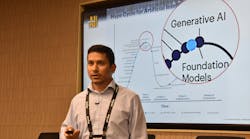BIRMINGHAM, Alabama—Artificial intelligence is currently at “the peak of the hype cycle,” and between that high point of expectations and the eventual implementation of productive technology lies the “trough of disillusionment,” explained McLeod Software representatives to open the transportation management technology company’s first AI Conference here this week. However, the big question is just how deep that trough will be and how long it will take before AI tools make fleets more efficient and profitable.
Or maybe the technology is positioned to jump directly from a promising concept to a fully realized tool, McLeod Software President and CEO Tom McLeod suggested to open the conference. He noted that, in one form or another, artificial intelligence and machine learning concepts have been around for 40 years or more.
The difference maker is the recent surge in affordable computing power and data storage capacity, making AI technologies accessible and practical.
“So it’s a technology that appears to be at the inflection point,” McLeod said. “That’s the tipping point where wide technology adoption can begin. And once that starts, typically, the technology becomes ubiquitous. Technologies tend to saturate the market in 10 years or less. We’ve had a number of examples of that over the last 100 years, and we appear to be potentially at that point with artificial intelligence.”
The company has been using machine learning in its rate predictor tool for a while but is now looking at AI to manage unstructured data.
“This would include taking unstructured emails, turning them into orders; taking unstructured requests for quotes and turning that into an automated response with recommendations; and using the generative AI tool for a request for information,” he said. “What we’re doing is helping to automate the routine things that you have to do manually right now to make your company more productive.”
See also: How AI could change trucking in 2024
Indeed, the purpose of the AI conference was to show customers how they can gain a competitive advantage and become more efficient by using the new tools.
“Ultimately, to be sustainable, these technologies have to be economically viable,” McLeod said. “They’ve got to be tied to process improvement. How can you be more profitable and serve your customers better? So that’s the vision we’re wanting to present today.”
Long-term potential
McLeod Software Data Scientist Sujit Kunwor opened his presentation with video of several human-shaped robots performing some impressive feats, including running a parkour course and doing aerial acrobatics costumed as Spider-Man. He also showed clips of their impressive fails.
“There are endless opportunities for these AI tools not just in robotics, but in transportation and across many industries. But what are the biggest use cases today?” Kunwar asked, before showing an image of a Corgi in a doghouse made of sushi rolls. “Yes, being able to generate cute pictures of dogs. Unless you're a cat person, you can generate images of cats.”
Kunwor outlined the history of AI, from its inception in 1956 to the current third wave of generative AI, highlighting the growth and innovation in the field over the past 10 years: The recent breakthroughs include computer vision, natural language processing, and the development of algorithms to support video and image generation—as well as the public and investor interest in AI.
But it’s the “instant gratification” and sense of empowerment that has driven generative AI to the peak of the hype cycle. (As I’m writing this, I’m watching a Billy Joel video that features an AI-generated version of the piano player, as he looked in the 1970s, singing a brand new song.)
“There's innovation growth in transportation, but the companies are not growing at rapid speed, as we see in AI in general,” Kunwor said.
Near-term and practical
So what can fleets expect, and when?
“Optimization of dispatch is the hardest problem, probably, and nobody has solved it completely,” he said. “And it's not solvable completely: Whatever solution you build, it may not work for others because every company works differently—there are some custom items that would not apply for everyone.”
Freight pricing and bidding is another area ripe for AI tools and would be tied to rate forecasting models, which McLeod already offers, Kunwor noted. The company hopes to use AI to extend the forecasting range and accuracy.
Predictive maintenance and in-cab driver analytics are also areas that AI will be able to better model, compared to current tools.
Indeed, of the ATRI list of Top 10 trucking challenges, five—ranging from driver retention to truck parking—could be solved with AI tools, he suggested.
Finally, autonomous trucking finally might achieve its much-ballyhooed potential (vehicle autonomy has slipped from the hype peak more than 5 years ago into the “trough of disillusionment,” according to the cycle curve), thanks to AI.
“There's a lot of AI going on in that truck, right? You know, you're getting images, you're getting a data stream from different machines, and different sensors,” Kunwor said.
As for natural language processing, McLeod is “looking very closely” at how fleets can benefit from such tools. Kunwor pointed to the development of a knowledge base, built on collections of thousands of documents, to create step-by-step instructions for a certain task, for instance. Similarly, AI-based customer service tools will be able to access a knowledge base and respond to queries with “cross-platform” actions.
For document processing tasks, AI can make sense of unstructured data in ways that current OCR tools cannot, such as finding an invoice number that might not be in place on every form.
“OCR is a time saver, but imagine someone going through each of those documents, extracting information from those documents—it's human hours, but image processing tools now can do that in a split second. That is a huge productivity boost for everyone.”
Similarly, email-parsing tools can make sure opportunities aren’t missed in a crowded inbox, passing along an additional alert and even taking steps to respond.
“We're trying to bring some of these tools to our customers,” Kunwor said. “So, exciting times for that.”






